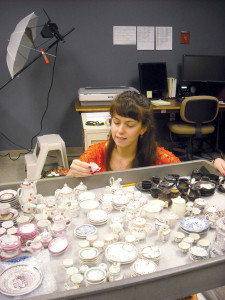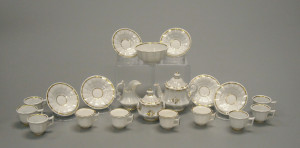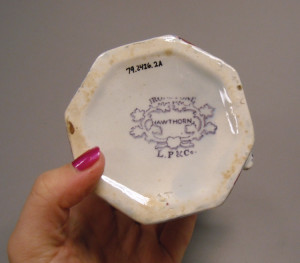Tea Sets and Play
EMERGING SCHOLARS > SUMMER RESEARCH GRANTS
By Nina Ranalli
Many scholars before me have embarked on studies of tea-drinking in early America; but passion for the material and generous funding from the Decorative Arts Trust allowed me to pursue the topic from a fresh perspective this past summer. It is the persistent focus on gentility by previous scholars that I would like to complicate by examining the presence and meaning of children’s tea sets in the early-mid 19th century. By this time tea and teawares were available not only to the middle class but also segments of the working class. Therefore, studying this period allows me to identify a phenomenon that touches many members of American society, and represents more than a marker of social class.
My study of a group of miniature tea sets at the National Museum of Play at the Strong revealed several patterns. Sets were often extensive in size and contained distinct parts: a number of cups and saucers, a teapot, a creampot, a sugar bowl. This pattern imposes order on the user of these objects. That each part is intended for a specific purpose was likely not lost on the children who played with these sets; social rules are implicit in the objects, and it seems clear that children began to enter into adult society by playing with them. Furthermore, many of the sets I studied are porcelain, thinly potted and fragile. None of the sets can be definitively linked to an American maker. The only set that bears a manufacturers mark was made in Staffordshire, England. Most sets show minor damage, especially chipping around the rims of the cups and saucers.
Only one set I examined contains a slop-bowl; the absence of this component from most sets, along with the complete lack of evidence of miniature water-urns, may be explained by the fact that it is unlikely children used the sets to consume tea. The Treatise on Domestic Economy speaks unequivocally on this issue: tea-drinking is not safe for children. Catherine Beecher says that tea and coffee are “seldom or never agreeable to children.” She also expresses a particular concern for younger or smaller children, noting: “It is this child who ordinarily becomes the victim to stimulating drinks. The tea and coffee which the parents and the healthier children can use without immediate injury, gradually sap the energies of the feebler child, who proves either an early victim, or a living martyr to all the sufferings that debilitated nerves inflict.”1 This and other home economics sources suggest that children might be satisfied with hot water, sometimes mixed with sugar or milk.
Even if they were not used as functional objects to consume tea, they were used as teaching tools and as socializing devices. Advice and domestic manuals, too, support this claim. An article in the July 1866 issue of Godey’s Lady’s Book entitled “Domestic Education” indicates that competency in the tea ritual was an important part of a young woman’s maturing: “The next great step is in allowing little miss to make the tea, which is a very great promotion indeed, and ere many years go by she presides at the tea and breakfast table with a perfect sense of what is required of her.”2
But we all know that just because rules and conventions are published does not mean that they are followed. Did children simply play with these tea sets? If so, how did they play with them, and what did it mean? One mid-nineteenth century children’s book, Dolls House-Keeping,3 contains several of the answers that I found repeatedly in children’s literature. One illustration shows a teacup upside-down on its saucer, with a spoon set at a jaunty angle through the handle and a wooden doll lying on her stomach atop the teacup. This confirms that teacups were used in play totally unconnected to tea-drinking; that they became simply things to be used in constructing whatever world a child saw fit.
A story in the book entitled “An Only Child’s Tea Party,” narrates a girl’s game of tea-party, which she is the only human to attend. These forms of play—totally unrelated to tea-drinking, or contrary to the social nature of the activity—show children undermining social order through play. While these toys were particularly important for girls, there is evidence that boys used them as well. A story called “Don’t Break it, Jose” which appeared in the Baltimore Patriot in 1830 includes a mother trying to distract her unruly son with a “little tea set.”4 An 1865 newspaper indicates that a little boy played with his sister’s miniature tea set at his birthday supper.5
My summer research revealed that, in addition to their use as teaching tools for girls, miniature tea sets were also used simply for the enjoyment of children. As I continue my research, I hope that considering the nature of play and the existence of miniature tea sets can complicate the current understanding of tea-drinking practices.
Footnotes:
1 Catharine Beecher, A Treatise on Domestic Economy, ( New York : Harper & Brothers, 1849), 109-110.
2 Mrs. Francis, “Domestic Education,” Godey’s Lady’s Book, July, 1866.
3 Juliana Horatia Gatty Ewing, Dolls House-Keeping, (New York: E. & J.B. Young, 1841-1885). Located at Rare Books and Special Collections Cotsen Children’s Library, 5856.
4 “Don’t Break it, Jose,” Baltimore Patriot, February 8, 1830.
5 E.B.H., “Children,” Zion’s Herald and Wesleyan Journal, July 12, 1865, 36.
SAVE THE DATE
- Special Symposium
“Classical Splendor”
The Philadelphia Museum of Art
November 4, 2016 - New York Antiques Weekend
January 20-21, 2017 - Spring Symposium
Savannah
April 21-24, 2017 - Spring Study Trip Abroad
Scotland
May 14-22, 2017 - Fall Symposium
Hartford & Western Connecticut
September 2017 - Fall Study Trip Abroad
Venice and the Veneto
October 9-16 and 22-29, 2017
By Nina Ranalli
Many scholars before me have embarked on studies of tea-drinking in early America; but passion for the material and generous funding from the Decorative Arts Trust allowed me to pursue the topic from a fresh perspective this past summer. It is the persistent focus on gentility by previous scholars that I would like to complicate by examining the presence and meaning of children’s tea sets in the early-mid 19th century. By this time tea and teawares were available not only to the middle class but also segments of the working class. Therefore, studying this period allows me to identify a phenomenon that touches many members of American society, and represents more than a marker of social class.
My study of a group of miniature tea sets at the National Museum of Play at the Strong revealed several patterns. Sets were often extensive in size and contained distinct parts: a number of cups and saucers, a teapot, a creampot, a sugar bowl. This pattern imposes order on the user of these objects. That each part is intended for a specific purpose was likely not lost on the children who played with these sets; social rules are implicit in the objects, and it seems clear that children began to enter into adult society by playing with them. Furthermore, many of the sets I studied are porcelain, thinly potted and fragile. None of the sets can be definitively linked to an American maker. The only set that bears a manufacturers mark was made in Staffordshire, England. Most sets show minor damage, especially chipping around the rims of the cups and saucers.
Only one set I examined contains a slop-bowl; the absence of this component from most sets, along with the complete lack of evidence of miniature water-urns, may be explained by the fact that it is unlikely children used the sets to consume tea. The Treatise on Domestic Economy speaks unequivocally on this issue: tea-drinking is not safe for children. Catherine Beecher says that tea and coffee are “seldom or never agreeable to children.” She also expresses a particular concern for younger or smaller children, noting: “It is this child who ordinarily becomes the victim to stimulating drinks. The tea and coffee which the parents and the healthier children can use without immediate injury, gradually sap the energies of the feebler child, who proves either an early victim, or a living martyr to all the sufferings that debilitated nerves inflict.”1 This and other home economics sources suggest that children might be satisfied with hot water, sometimes mixed with sugar or milk.
Even if they were not used as functional objects to consume tea, they were used as teaching tools and as socializing devices. Advice and domestic manuals, too, support this claim. An article in the July 1866 issue of Godey’s Lady’s Book entitled “Domestic Education” indicates that competency in the tea ritual was an important part of a young woman’s maturing: “The next great step is in allowing little miss to make the tea, which is a very great promotion indeed, and ere many years go by she presides at the tea and breakfast table with a perfect sense of what is required of her.”2
But we all know that just because rules and conventions are published does not mean that they are followed. Did children simply play with these tea sets? If so, how did they play with them, and what did it mean? One mid-nineteenth century children’s book, Dolls House-Keeping,3 contains several of the answers that I found repeatedly in children’s literature. One illustration shows a teacup upside-down on its saucer, with a spoon set at a jaunty angle through the handle and a wooden doll lying on her stomach atop the teacup. This confirms that teacups were used in play totally unconnected to tea-drinking; that they became simply things to be used in constructing whatever world a child saw fit.
A story in the book entitled “An Only Child’s Tea Party,” narrates a girl’s game of tea-party, which she is the only human to attend. These forms of play—totally unrelated to tea-drinking, or contrary to the social nature of the activity—show children undermining social order through play. While these toys were particularly important for girls, there is evidence that boys used them as well. A story called “Don’t Break it, Jose” which appeared in the Baltimore Patriot in 1830 includes a mother trying to distract her unruly son with a “little tea set.”4 An 1865 newspaper indicates that a little boy played with his sister’s miniature tea set at his birthday supper.5
My summer research revealed that, in addition to their use as teaching tools for girls, miniature tea sets were also used simply for the enjoyment of children. As I continue my research, I hope that considering the nature of play and the existence of miniature tea sets can complicate the current understanding of tea-drinking practices.
Footnotes:
1 Catharine Beecher, A Treatise on Domestic Economy, ( New York : Harper & Brothers, 1849), 109-110.
2 Mrs. Francis, “Domestic Education,” Godey’s Lady’s Book, July, 1866.
3 Juliana Horatia Gatty Ewing, Dolls House-Keeping, (New York: E. & J.B. Young, 1841-1885). Located at Rare Books and Special Collections Cotsen Children’s Library, 5856.
4 “Don’t Break it, Jose,” Baltimore Patriot, February 8, 1830.
5 E.B.H., “Children,” Zion’s Herald and Wesleyan Journal, July 12, 1865, 36.




